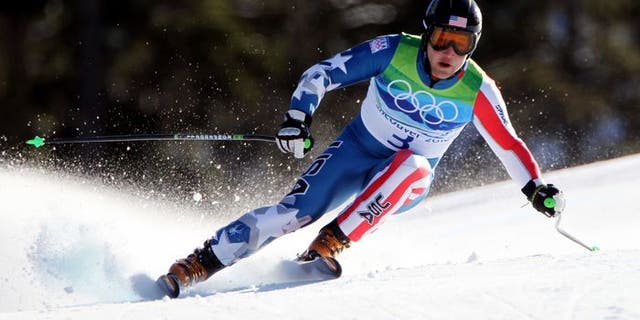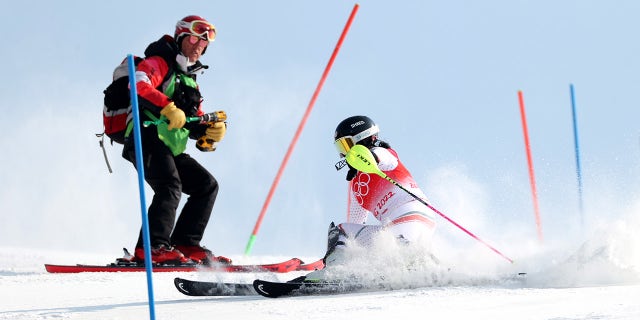NEWYou can now listen to Fox News articles!
The problem with U.S. alpine skiing at the Beijing Olympics isn’t that Mikaela Shiffrin didn’t win an individual medal. The problem is that she was the only U.S. skier expected to win one.
Entering Saturday’s mixed team parallel event — a newer discipline that some top alpine nations don’t take seriously — the U.S. medal total sits at one: Ryan Cochran-Siegle’s surprise silver medal in the super G. That’s the U.S. alpine ski team’s lowest total since 1998, when it also had one medal.
The future could be bleaker than that. In recent years, the U.S. alpine racing pipeline has been threatened by a daunting force: a ballooning price tag.
The total cost for a junior ski racing career can top $500,000, according to a 2019 survey by U.S. Ski & Snowboard of ski clubs, academies and colleges. That total includes everything from ski camps and academy tuition to more-specialized equipment and racing fees.
Former ski racers and parents are sounding the alarm as they watch the sport’s shift toward the extremely wealthy.
“We’re going to run into trouble as a country,” said Andrew Weibrecht, a U.S. Olympic medalist in the super G in 2010 and 2014 who recently became active in skiing governance because of his concerns about rising costs. “The pool is going to become so shallow that it’s going to become difficult to find the most talented athletes.”
In response to emailed questions, Sophie Goldschmidt, President and CEO of U.S. Ski & Snowboard acknowledged, “Cost is an issue for attracting and retaining athletic talent, and we need to continue to find ways to keep costs down in this country. Without government funding in these sports our athletes are reliant on the support of donors, sponsors, clubs, resort partners, volunteers and our larger sport community to make it possible to pursue their dreams.”
The total cost for a junior ski racing career can top $500,000, according to a 2019 survey by U.S. Ski and Snowboard of ski clubs, academies and colleges.
(Gabriele Facciotti/Associated Press)
Ski racing has never been cheap. But it was long accessible to people with more modest means and those who lived in or near mountain towns, said Steve Porino, an American former racer working as an NBC Olympics commentator. Now, racing in the U.S. is for one-percenters, he said.
“Ski racing is getting more expensive around the world,” Porino said. “But we lead the charge.”
Those with enough money can send their kids to offseason training in New Zealand to get them ready for competitions that start as early as October. In a 2020 essay on Skiracing.com, Porino called the advantages gained by higher-spending parents “financial doping.”
Steve Crowley said high costs helped drive the elder of his two daughters out of highly competitive ski racing. She now races for her high school team. Costs are also weighing on his family for his 14-year-old daughter, Audrey Crowley, a competitive Paralympic skier, he said.
Steve Crowley works in sales for a company that sells high-end home electronics systems. He and his wife work second jobs in the ski industry — the family lives in Eagle, Colorado, near Vail — that secure them discounts on ski expenses.
AMERICAN PAIRS SKATER TIMOTHY LEDUC MAKES HISTORY AS FIRST NONBINARY WINTER OLYMPIAN
Crowley estimates his family is spending $30,000 this year on Audrey’s ski racing, and that “when she gets to 17, that’ll jump at least another $10,000-$15,000.” At that point, fundraising would be the only way for the family to afford to keep her in racing, he said.
U.S. Ski & Snowboard’s Goldschmidt said ski club programming fees are the biggest chunk of young athletes’ racing costs, and that they are driven by broader economic forces. The survey said those fees and a season pass can cost up to $18,000 at a club and $50,000 at a ski academy for an under-14 racer.

Andrew Weibrecht was a U.S. Olympic medalist in the super G in 2010 and 2014.
(Doug Pensinger/Getty Images)
One trend driving costs is the movement toward chasing points. Those who start skiing early in the year can collect racing points, move up the rankings and give themselves better start positions, making it hard for others to catch up during the rest of the season.
Goldschmidt said statistically, junior skiers aren’t racing more than in the past but acknowledged that a drive to race more to improve rankings does drive up travel costs for some.
SIMONE BILES OFFERS MIKAELA SHIFFRIN SUPPORT AMID WINTER OLYMPICS CRITICISM: ‘PEOPLE SUCK’
The push toward points-chasing and away from a young skier’s actual skill and technique is a change from even a decade or two ago, when Weibrecht was growing up in Lake Placid, N.Y., skiing mostly at his local ski area and racing mostly locally.
Weibrecht is like many successful high-level American skiers of the past: He grew up playing multiple sports, concentrating on ski racing starting in his teens and got his best ski instruction through a strong local program.
Now, he said, “You see parents not letting their kids play soccer because they are focusing on their ski-racing fitness.”
Increasingly specialized equipment — and the means that some young skiers have to tinker with it — can be another barrier to skiers without wealth. Weibrecht recalls racing on hand-me-down skis and experimenting with waxing them by melting candles from his parents’ restaurant. When he was racing at the under-14 level, race officials limited kids to one pair of skis, even taking down the serial number.
“It really leveled the playing field,” Weibrecht recalled. “Now I see kids at a young age with multiple pairs of skis. I think it’s a cultural shift that’s happened, a change in mentality.”
Efforts to address the cost problem haven’t gained traction. Weibrecht, who’s on committees at the U.S. Olympic & Paralympic Committee and U.S. Ski & Snowboard, said an initiative to limit young racers to one pair of skis met with resistance from some in the ski industry. So have moves to curb the number of races kids enter.
“There’s definitely incentives to not try to reduce the cost of the sport,” Weibrecht said.

Eva Vukadinova of Team Bulgaria skis her run while a course worker is still repairing a broken gate during the Women’s Slalom Run 1 on day five of the Beijing 2022 Winter Olympic Games at National Alpine Ski Centre Feb. 9, 2022, in Yanqing, China.
(Alex Pantling/Getty Images)
For its part, U.S. Ski & Snowboard has encouraged the use of domestic venues to keep costs down, worked with resort partners on affordable lift access and promoted the use of lower-cost equipment at younger ages.
CLICK HERE TO GET THE FOX NEWS APP
One of the most concrete shifts came about by accident: a scaling back of race calendars during the pandemic. Athletes are now racing closer to home more often and spending less money on lodging and meals. Goldschmidt said U.S. Ski & Snowboard has reinforced the approach “due to encouraging cost-effective results.”
This article originally appeared in The Wall Street Journal